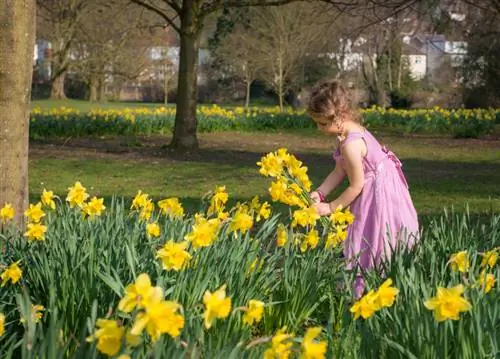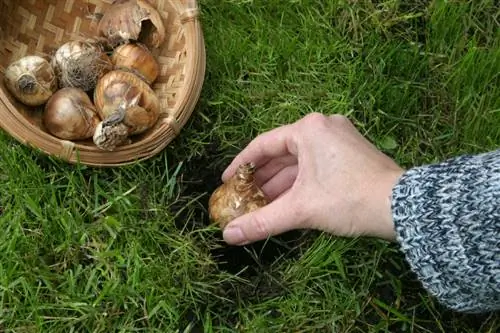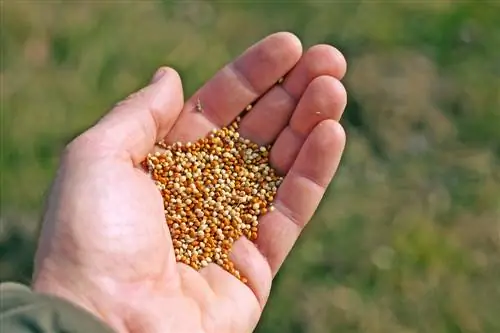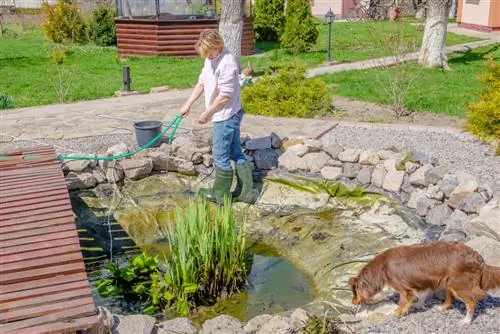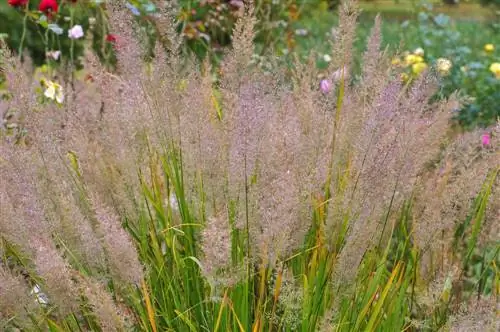- Author admin [email protected].
- Public 2023-12-25 17:45.
- Last modified 2025-01-23 11:22.
In the spring garden, daffodils compete with the sun. So that the golden-yellow flower beauty always announces the most beautiful time of the year for many years to come, the gardening bar is not set high. You can find out which measures dominate cultivation here.

How do you care for daffodils properly?
You care for daffodils by watering them when it is dry, fertilizing them organically from March until the end of flowering and adding liquid fertilizer to the water in the pot every 14 days. Wilted flower heads should be removed and the foliage should only be cut off when it has withered completely.
Planting daffodils correctly
Daffodils perform the early flowering miracle because the flower sprouts from a bulb. The basic requirement for the process is professional planting at the right time. You can do it in these steps:
- In September/October, loosen the soil thoroughly in a sunny to partially shaded location
- Create small planting pits at a distance of 15-20 cm, with a thin layer of sand at the bottom
- Improve the excavation with compost, guano and horn shavings
- Insert one onion at a time with the tip pointing upwards
- The ideal planting depth is two to three times the radius of the bulb
Place the flower in small tuffs of 5-9 specimens and then water generously.read more
Care tips
The clear care program for daffodils includes these recommendations:
- Water the flower when it is dry
- Fertilize organically from March until the end of the flowering period
- Add liquid fertilizer for flowering plants to the water in the pot every 14 days
- Cleaning up wilted flower heads
Once the flower has finished its blossom festival for the season, give the bulb enough time to absorb the remaining nutrients from the leaves. Only then do you cut the leaves close to the ground. Please don't forget your gloves.read more
Which location is suitable?
If you take your sunny disposition into account when choosing the location, daffodils will shine in the spring sun in all their splendor. The flower also looks impressive in partial shade. To prevent violent spring storms from breaking the stems, we recommend a location sheltered from the wind.read more
The correct planting distance
Where several daffodils gather, they form small islands of spring-like opulence. Therefore, plant the flower in small tuffs with 5-9 specimens at a planting distance of 15-20 centimeters.
What soil does the plant need?
Daffodils feel at home in normal garden soil. The following attributes are beneficial:
- Nutritional and humic
- Fresh-moist, with good water drainage
- Neutral to slightly acidic pH value
What is the best time to plant?
In order for daffodils to fulfill their role as a herald of spring on time, the right planting time is important. If you plant the bulbs in the ground in September or October, the bright yellow and white trumpet flowers will be there in time.read more
When is flowering time?
The flowering period of daffodils extends from February to May. However, a single flower does not have such staying power. If you combine varieties with early, medium and late flowering, the spring splendor blends seamlessly into one another. The following arrangement may serve as inspiration:
- February Gold: Flowering period from mid-February to early April
- Ice Follies: flowering period from March to April
- Golden Ducat: flowering time in April
- Thalia: flowering period from April to May
read more
Cut daffodils correctly
There are several occasions to cut daffodils. The following brief overview also gives you tips on how to proceed correctly:
- Cut daffodils as vase decorations when the buds have recently opened
- Cut wilted flower heads to avoid seed formation
- After flowering, only cut the foliage when it has completely withered
read more
Watering daffodils
Daffodils prefer varying soil moisture with intermittent drying periods. Water the flower like this:
- If the surface of the earth dries, it is watered
- Do not water the flower, but water directly to the roots
- Check the moisture content of the soil in the bucket daily using a thumb test
Do not leave water standing in the pot saucer for a long time, as waterlogging inevitably leads to onion rot.read more
Fertilize daffodils properly
Daffodils are low-eaters, so their nutrient requirements are within manageable limits. Fertilize the flower in the bed with compost, guano or nettle manure in March and April. Apply a liquid fertilizer (€9.00 on Amazon) in the planter every 14 days during the flowering period.read more
Diseases
While commercial growers have to deal with a number of viral diseases on daffodils, the danger to the flower in the hobby garden is limited to bulb basal rot. This fungal infection means the end because the underground survival organ rots beyond repair. Look for yellowing daffodil leaves in the middle of the season as a telltale symptom. Discard the infected flower immediately to prevent spread.
Pests
The most important pest for the flower are the small and large daffodil flies. The females lay their eggs in the immediate vicinity of the bulb in June. Over the course of the summer, the larvae bore into the flower bulb and eat it from the inside out. Since an infestation can hardly be diagnosed in time, you won't notice the disaster until the following spring. The leaves are stunted and the flowers remain puny. To prevent the little bidders from multiplying again, discard the onion and mix the soil with quicklime.
Wintering
Freshly planted daffodil bulbs should be protected with leaves, straw and brushwood in the first winter. Once the flower has established itself in the bed, no special precautions are required for overwintering. On the contrary, the winter cold stimulus is essential for flower induction. Cultivate the flower in the pot, wrap the container with bubble wrap before the first frost and cover the substrate with leaves, straw or sawdust.read more
Propagate daffodils
Numerous species of daffodils, such as the poet's daffodil, the trumpet daffodil or the cyclamen-flowered daffodil, tend to go wild, so they reproduce quickly on their own. To speed up this process, do this:
- Lift a well-established daffodil bulb from the ground in September/October
- Separate one or more daughter bulbs with a sharp knife
- In the new location, place in the soil in a sunny to semi-shady location and water well
- Before replanting the mother plant, enrich the soil with compost and horn meal
Sowing seeds, on the other hand, proves to be significantly more complex. Since these are cold germinators, stratification is necessary. In addition, it takes up to 4 years for the first flower to appear.read more
How do I transplant correctly?
Transplanting daffodils is easy to do and definitely desirable. By the fifth year at the latest, this measure will make a valuable contribution to maintaining the vitality and blooming ability of this flower. This is how the plan works:
- After flowering or in September/October, dig up the bulb with a digging fork or your hands
- Cut off the daughter bulbs with a sharp, disinfected knife
- Enrich the soil with compost at both the current and new location
Place the flower at a depth that is twice to three times the diameter of the bulb and water.read more
Daffodils in a pot
In pots, daffodils exude their charm in a sunny location from February onwards if you plant the bulbs in September of the previous year. Use compost-based potting soil as a substrate and add a handful of sand or perlite. The planting depth is at least twice the diameter of the bulb. Drainage above the water drain is essential. Until the end of December/beginning of January, keep the pot in a cool, frost-free cellar and do not allow the substrate to dry out. From January you care for the flower like this:
- Place on the sunny to partially shaded windowsill at temperatures around 15 degrees
- Gradually increase the amount of watering as soon as budding begins
- When the flowering period begins, fertilize liquidly every 14 days
At the end of the flowering period, cut off the stems and leaves if they are completely withered. Keep the bulbs dry in the cool, dark basement over the summer or plant them in the garden soil.read more
Is daffodils poisonous?
As part of the amaryllis family, the daffodil contains alkaloids and other toxins that are extremely harmful to humans and animals. Unfortunately, the flower bulb is similar to a kitchen onion, meaning that life-threatening poisoning has occurred due to accidental consumption. Pay close attention when within reach of children and pets or avoid cultivating this flower altogether. Wearing gloves during any contact is a gardener's top priority.read more
Daffodils not blooming
If the flower lacks its splendor, this is how it expresses its displeasure. It is important to discover and resolve the bottleneck within cultivation that is responsible for this. The following causes cause flower failure:
- Nutrient deficiency: administer an immediately effective liquid fertilizer
- Overfertilization: stop adding fertilizer this year
- Ageing: dig up, divide and place in fresh soil
- Too little light: change location to a sunny location
Brown leaves
If the leaves of a daffodil turn brown immediately after budding or during flowering, the following reasons are behind it:
- Frostbite due to severe ground frost: protect with garden fleece
- Drought: water more often
- Waterlogging: plant in a damp location on a small hill
- Vole feeding: putting onions in the vole basket
Yellow leaves
If the magnificent foliage of a daffodil turns yellow in the middle of the flowering period, this damage indicates onion basal rot. This fungal infection causes rot within the survival organ, so that the supply to the above-ground parts of the plant comes to a standstill. The leaves turn yellow and the entire flower dies. Dispose of the infected daffodil immediately with household waste to prevent it from spreading.
The most beautiful varieties
- Acropolis: double flowers in bright white, with an orange heart and a wonderful scent
- Arctic Gold: yellow-gold trumpet daffodil, the incarnation of an Easter bell with an extra long flowering period from March to May
- Cherry Spot: the trendy daffodil with white petals and orange-red side crown
- February Gold: the earliest flower among the daffodils, which unfolds its golden yellow flowers from February
- Manly: its delicate yellow coloring belies its robust constitution
- Rip van Winkel: with a petite 15 cm height, the double flower enchants in beds and pots from April to May

